
Hieronymus Bosch was a Dutch painter from Brabant. He is one of the most notable representatives of the Early Netherlandish painting school. His work, generally oil on oak wood, mainly contains fantastic illustrations of religious concepts and narratives. Within his lifetime, his work was collected in the Netherlands, Austria, and Spain, and widely copied, especially his macabre and nightmarish depictions of hell.

The Adoration of the Magi or Adoration of the Kings or Visitation of the Wise Men is the name traditionally given to the subject in the Nativity of Jesus in art in which the three Magi, represented as kings, especially in the West, having found Jesus by following a star, lay before him gifts of gold, frankincense, and myrrh, and worship him. It is related in the Bible by Matthew 2:11: "On entering the house, they saw the child with Mary his mother; and they knelt down and paid him homage. Then, opening their treasure chests, they offered him gifts of gold, frankincense, and myrrh. And having been warned in a dream not to return to Herod, they left for their own country by another path".

The Wallraf–Richartz Museum is an art museum in Cologne, Germany, with a collection of fine art from the medieval period to the early twentieth century. It is one of the three major museums in Cologne.

The Adoration of the Magi is an unfinished early painting by the Italian Renaissance artist Leonardo da Vinci. Leonardo was given the commission by the Augustinian monks of San Donato in Scopeto in Florence in 1481, but he departed for Milan the following year, leaving the painting unfinished. It has been in the Uffizi Gallery in Florence since 1670.

The Haywain Triptych is a panel painting by the Early Netherlandish painter Hieronymus Bosch, now in the Museo del Prado, Madrid, Spain. A date of around 1516 has been established by means of dendrochronological research. The central panel, signed "Jheronimus Bosch", measures 135 cm × 200 cm and the wings measure 147 cm × 66 cm. The outside shutters feature a version of Bosch's The Wayfarer.
Events from the year 1504 in art.
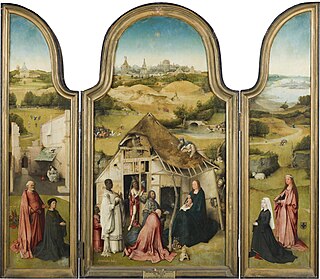
The Adoration of the Magi or The Epiphany is a triptych oil painting on wood panel by the Netherlandish artist Hieronymus Bosch, executed around 1485–1500. It is now in the Museo del Prado in Madrid, Spain.
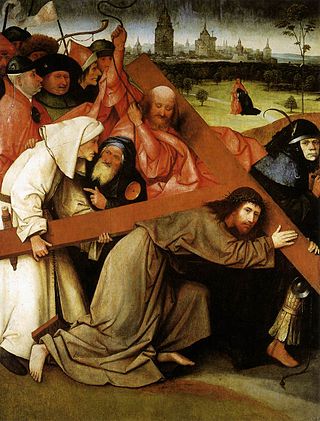
Christ Carrying the Cross is an oil on panel painting created c. 1505–1507 by the Early Netherlandish artist Hieronymus Bosch. It is held at Palacio Real, in Madrid.

Christ Carrying the Cross is a painting attributed to a follower of Hieronymus Bosch. It was painted in the early 16th century, presumably between 1510 and 1535. The work is housed in the Museum of Fine Arts in Ghent, Belgium. The painting is notable for its use of caricature to provide grotesque-looking faces surrounding Jesus.

Christ Carrying the Cross is an oil on panel painting by the Dutch artist Hieronymus Bosch, executed most likely c. 1490–1500. It is at the Kunsthistorisches Museum, in Vienna, Austria.
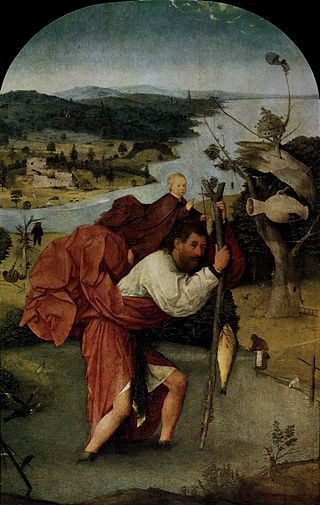
Saint Christopher Carrying the Christ Child is an oil on panel painting by Dutch painter Hieronymus Bosch, dating to c. 1490–1500. It is in the Museum Boijmans Van Beuningen in Rotterdam.

Christ Child with a Walking Frame is a part of an altarpiece by Netherlandish artist Hieronymus Bosch, painted on the reverse of his Christ Carrying the Cross. Measuring 28 centimetres (11 inches) in diameter, it is at the Kunsthistorisches Museum, Vienna, Austria.
Events from the year 1505 in art.
Adoration of the Christ Child may refer to one of the following Renaissance paintings:
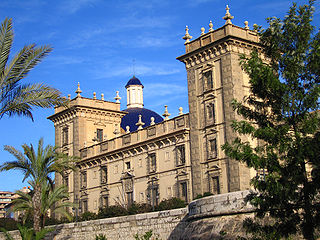
The Museu de Belles Arts de València is an art gallery in Valencia, Spain, founded in 1913. It houses some 2,000 works, most dating from the 14th–17th centuries, including a Self portrait of Diego Velázquez, a St. John the Baptist by El Greco, Goya's Playing Children, Gonzalo Pérez's Altarpiece of Sts. Ursula, Martin and Antony and a Madonna with Writing Child and Bishop by the Italian Renaissance master Pinturicchio. It houses a large series of engravings by Giovan Battista Piranesi.

The Lázaro Galdiano Museum is an art museum in Madrid, Spain. It houses the art collection of José Lázaro Galdiano. The museum was inaugurated on 27 January 1951.

The Adoration of the Kings is an oil-on-panel painting of the Adoration of the Magi by the Netherlandish Renaissance artist Pieter Bruegel the Elder, painted in 1564, and now in the National Gallery, London.

The Triptych of Temptation of St. Anthony is an oil painting on wood panels by the Early Netherlandish painter Hieronymus Bosch, dating from around 1501. The work portrays the mental and spiritual torments endured by Saint Anthony the Great, one of the most prominent of the Desert Fathers of Egypt in the late 3rd and early 4th centuries. The Temptation of St. Anthony was a popular subject in Medieval and Renaissance art. In common with many of Bosch's works, the triptych contains much fantastic imagery. The painting hangs in the Museu Nacional de Arte Antiga in Lisbon.
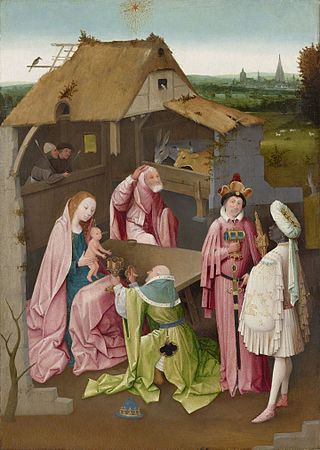
The Adoration of the Magi is an oil painting on wood panel attributed to the workshop of Netherlandish artist Hieronymus Bosch, executed around 1499. It is housed in the Philadelphia Museum of Art, USA. The museum's catalog assign it to around 1518, as having been finished by Bosch's workshop. According to Dendochronologic research, it could have been painted in 1493–1499.

The Adoration of the Magi is an oil painting on wood panel by Netherlandish artist Hieronymus Bosch, executed around 1475. It is housed in the Metropolitan Museum, New York, US. A prominent feature of this painting is the strong perspective effect and also the copious use of gold leaf, which is not very typical for Bosch. The pigments employed are red lake, azurite, lead-tin-yellow and ochres.

















